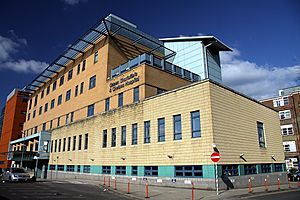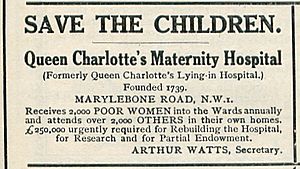Queen Charlotte's and Chelsea Hospital facts for kids
Quick facts for kids Queen Charlotte's and Chelsea Hospital |
|
|---|---|
| Imperial College Healthcare NHS Trust | |

Queen Charlotte's and Chelsea Hospital Main Building
|
|
| Lua error in Module:Location_map at line 420: attempt to index field 'wikibase' (a nil value). | |
| Geography | |
| Location | Du Cane Road, London, W12 0HS, England |
| Organisation | |
| Care system | NHS England |
| Hospital type | Specialist |
| Affiliated university | Imperial College London |
| Services | |
| Emergency department | No |
| Speciality | Maternity, obstetrics and neonatal care services |
| History | |
| Founded | 1739 |
Queen Charlotte's and Chelsea Hospital is a very old hospital in London, England. It was started in 1739 and is one of the oldest hospitals in Europe that helps women have babies. Today, it is located between East Acton and White City, right next to Hammersmith Hospital. The Imperial College Healthcare NHS Trust manages the hospital.
Contents
Hospital History
The hospital began in 1739. Sir Richard Manningham opened a place for women to give birth on Jermyn Street. This was called the General Lying-in Hospital. It was the first hospital of its kind in Britain.
In 1752, the hospital moved to Marylebone Road. It became one of the first places to teach doctors and nurses about childbirth. In 1782, the hospital officially received a special licence to operate.
In 1809, Prince Augustus Frederick, Duke of Sussex asked his mother, Queen Charlotte, to support the hospital. She agreed, and the hospital was renamed the Queen's Lying-in Hospital. Queen Charlotte even held a special party each year to raise money for it.
The hospital moved again in 1813 to Lisson Green in Marylebone. It was completely rebuilt in 1856. In 1885, Queen Victoria gave the hospital a Royal Charter. This was a special document that made it an official royal institution. In 1923, its name changed to Queen Charlotte's Maternity Hospital and Midwifery Training School.
For a long time, it was dangerous for women to give birth in hospitals. A serious infection, sometimes called "childbed fever," was common. Doctors learned how this infection spread in 1931. Because of this, a special area was built on Goldhawk Road to keep infected patients separate. In 1940, the rest of the hospital moved to Goldhawk Road to be with this special isolation area.
In 1948, the National Health Service (NHS) was created. The hospital then joined with the Chelsea Hospital for Women. They became a combined teaching school. In 1988, the Chelsea Hospital for Women moved to the same site. The hospital was then called Queen Charlotte's & Chelsea Hospital. In 2000, the hospital moved to its current location on Du Cane Road.
Amazing Staff Members
- Alice Blomfield (1866–1938) was the head nurse (Matron) from 1908 to 1924. She helped expand the hospital's services. She also helped create the first special training school for midwives at a hospital like this. Alice gave talks about preventing blindness in babies and about training midwives.
- Elsie Knocker (1884–1978) trained as a midwife here. During the First World War, she became famous as a nurse and ambulance driver. She even received a special award called the Military Medal.
Hospital Facilities
The hospital has a special unit called the de Swiet Obstetric Medicine Centre. This unit helps pregnant women who have other health problems. It makes sure they get the best care during their pregnancy.
The hospital has two main areas for giving birth:
- Labour Ward: This is a larger area with 18 rooms. It offers a more traditional way to give birth. About 5,700 babies were born here between April 2016 and April 2017. Women here can get pain relief like epidurals.
- Birth Centre: This is a smaller, more home-like area with seven rooms. About 1,030 babies were born here between April 2017 and April 2018. The goal here is a natural birth without medical help. They use things like birth pools, and epidurals are not used.
Babies born in both areas can go to the neonatal intensive care unit (NICU) if they need special care.
The hospital also has a programme called "Jentle Midwifery." This programme gives mothers one-on-one care from the same midwife. The midwife supports them throughout pregnancy, during birth, and for four weeks after. This offers a more personal experience than standard NHS options.
Important Research
In 2016, the hospital teamed up with Tommy's National Centre for Miscarriages. This group helps fund research into problems during pregnancy. They opened a miscarriage clinic at the hospital. The goal is to understand why miscarriages happen and reduce them by 50% by 2030. They are looking into genetic causes and bacteria.
Another project in 2016 aimed to prevent cot death, also known as Sudden Infant Death Syndrome (SIDS). The hospital gave 800 families special foam mattresses inside cardboard boxes for their newborns. These boxes, which are popular in Finland, help keep babies safe while they sleep.
Today, the hospital is part of the Imperial College Healthcare NHS Trust. It is one of five teaching and research hospitals in London. They work on many research projects. These include studies on brain conditions like Parkinson's disease and treatments for certain cancers.
COSMIC Charity
COSMIC is a charity that helps the hospital's intensive care units for babies and children. They buy special equipment like patient monitors. They also fund training for staff. COSMIC gives emotional and practical help to families with children in intensive care. They also support research into childhood diseases.
How to Get There
You can reach the hospital by public transport. The closest bus stops are "Wulfstan Street" and "Hammersmith Hospital." The nearest underground station is East Acton tube station on the Central Line.
Famous People Born Here
Many well-known people were born at Queen Charlotte's and Chelsea Hospital, including:
- Alexander Aris, a civil rights activist
- Mischa Barton, an actress
- Sebastian Coe, a famous athlete
- Benedict Cumberbatch, an actor
- Roger Daltrey, a musician
- Danny Kustow, a pop musician
- Helen Mirren, an actress
- Daniel Radcliffe, an actor
- Zak Starkey, a pop musician
- Graeme K Talboys, an author
- Carol Thatcher, a journalist
- Mark Thatcher, a businessman
- Justin Welby, the Archbishop of Canterbury
See also
- British Lying-In Hospital
- List of hospitals in England
- Portland Hospital
- Samaritan Hospital for Women
- South London Hospital for Women and Children



